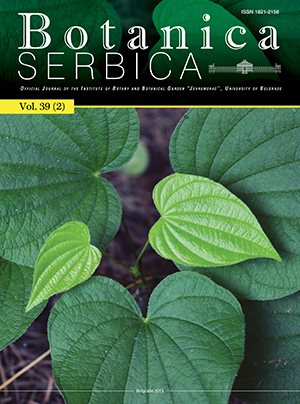
Volume 39 Issue 2 2015 |
Editorial
|
| |
Professor dr Mirjana Neškovic
|
| |
Professor dr Ljubinka culafic
|
| |
Secoiridoid glycosides production in hairy roots of Gentiana pneumonanthe L.: optimization of cytokinin concentration in the culture medium
|
Being genetically stable and fast-growing, HR cultures of G. pneumonanthe could provide a constant and highly productive source of valuable secondary metabolites, and could further be implemented in large-scale bioreactors. Although many challenges still exist for the commercial implementation of this alternative production system, the results presented here demonstrate the opportunities for enhanced SGs production by the application of in low concentrations of both cytokinins and thus highlight the benefits of optimizing growth conditions. KEY WORDS: Gentiana pneumonanthe, hairy roots, cytokinins, secoiridoid glycosides, secondary metabolites |
Effects of juglone on pea and maize seed germination, early seedling development and detoxification enzyme activities
|
KEY WORDS: allelopathy, juglone, quinonereductase, glutathione-s-transferase |
Tomato: a model species for fruit growth and development studies
|
KEY WORDS: tomato, fruit, growth, development |
In vitro morphogenesis and secretion of secondary metabolites of Nicotiana tabacum tall glandular trichomes
|
KEY WORDS: glandular trichomes, histochemistry, morphology, tobacco, ultrastructure |
In vitro cultures for micropropagation, mass multiplication and preservation of an endangered medicinal plant Sideritis scardica Griseb
|
KEY WORDS: Pirin mountain tea, Mursalitsa tea, seed germination, in vitro response, micropropagation, ex vitro |
Paraquat-mediated oxidative stress in Nepeta pannonica L.
|
KEY WORDS: Nepeta pannonica, paraquat, oxidative stress, rosmarinic acid. |
In vitro propagation of Iris reichenbachii Heuff. and clonal fidelity of regenerated plants
|
KEY WORDS: Iris, somatic embryogenesis, organogenesis, flowering, flow-cytometry |
Estimation of meristemoid complexity during Tacitus bellus in vitro shoot organogenesis by 2D fractal analysis
|
KEY WORDS: 2D Fractal Dimension; Shoot Organogenesis; Tacitus bellus |
Early flowering species - model plants for studies of ontogenesis in vitro
|
KEY WORDS: Chenopodium rubrum L., Chenopodium murale L., ontogenesis, flowering, in vitro, photoperiod. |
Induction of peroxidase isoforms in the roots of two Verbascum thapsus L. populations is involved in adaptive responses to excess Zn2+ and Cu2+
|
KEY WORDS: auxin, copper, NADH, peroxidase, populations, Verbascum thapsus, zinc. |
Differences in regenerative capacity of Oriental lily (Lilium sp.) cultivars
|
KEY WORDS: bulblets, somatic embryogenesis, regeneration, Oriental lilies, BA - 6-benzylamino purine, TDZ - thidiazurone (N-phenyl-N’-1,2,3-thiadiazol-5-yl urea), PIC – picloram |
Functional anatomy of vascular tissue as a tool to understand transport of water and assimilates into developing fruit
|
KEY WORDS: tomato, microscopy, hydraulic conductance, xylem, phloem, fruits |
An improved HPLC-DAD method for simultaneously measuring phenolics in the leaves of Tilia platyphyllos and Ailanthus altissima
|
KEY WORDS: HPLC method development; anthocyanins; flavonoid glycosides; phenolic acids, phenolic profiles; urban environment. |
Chenopodium murale hairy root exudates inhibit growth and induce oxidative stress in collard greens (Brassica oleracea L. var. acephala)
|
KEY WORDS: Allelopathy, Chenopodium murale, transformed roots, collard greens, inhibition, germination/ seedling growth |


